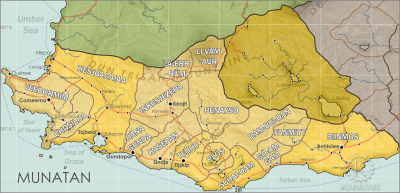Biinmos
Biinmos is a large, militarised state in eastern Munatan. It is sometimes known as Dendrost, a Hartheran version of its name. This is an anachronism and in modern diplomacy only the official name is used.
Munatanplugin-autotooltip__small plugin-autotooltip_bigMunatan (Category)
Articles about Munatan, the far southern region of Anásthias.
Nations
Cities
topics regi1
 Hover mouse to see more detail | Go to full atlas mapplugin-autotooltip__small plugin-autotooltip_bigAtlas: Munatan
Hover mouse to see more detail | Go to full atlas mapplugin-autotooltip__small plugin-autotooltip_bigAtlas: Munatan
[munatan.png] * Zoom out * East Munatan * West Munatan
Munatan
Munatan [Moo-Nah-Tahn] is the southernmost region of Anásthias, south of the Dun Trisan mountains. The name possibly derives from a ancient OrorrOrorrOrorrHartheraHartheraOrorrOrorrOrorrHartheraHartheraHartheran
This is in a series of articles about Munatanplugin-autotooltip__small plugin-autotooltip_bigMunatan
Munatan [Moo-Nah-Tahn] is the southernmost region of Anásthias, south of the Dun Trisan mountains. The name possibly derives from a ancient Thalsic, meaning “Land of One Sun”, since the daystar is not visible in the southern hemisphere. Or it may be a reference to the Manthi people who were once the majority population of western Munatan. The term is an OrorrOrorrOrorrHartheraHartheraOrorrOrorrOrorrHartheraHartheraHartheran, the temperate region of southern Anásthiasplugin-autotooltip__small plugin-autotooltip_bigAnásthias
Anásthias [a-NAS-thee-ass / ænæsθiːæs], or [an-ass-THEE-as] is an equatorial island continent, heart of the Civilised World. The north straddles the equator and is hot and humid, while most of the equatorial centre is an upland plateau with fertile river valleys, and stretches of arid plains and desert in the shadow of the mountains. The south is temperate but more wild, separated from the civilisations of the north by the almost impassable Harthera.
- Name: Biinmos
- Demonym: Biinmosa
- Government: Warlords
- Capital: Behtoïee
- Population:
- Currency:
- Foundation:
- Language:
Its capital is the fortified city of Behtoïee.
Biinmos is notorious for its fractious history of conflict and war. In the past 50 years Hartheranplugin-autotooltip__small plugin-autotooltip_bigHarthera
The Hartheran Union, commonly named Harthera, is an imperialist maritime nation state dominating the northeast of Anásthias. It is one of the two great powers of the modern epoch, arguably the most technologically and militarily powerful nation in the world, only matched by the vast size and wealth of its neighbour, viridOrorrMEOrorrOrorrOrorrOrorr influence has increased in the region, with trade enclaves virtually ruling the major port cities in the south, and Hartheran diplomats and “advisers” aiding various warlords in expanding and pacifying internal territories.
History
Biinmos formed around the valley of the River Druimi in the first millennium BMEplugin-autotooltip__small plugin-autotooltip_bigBME (Before Modern Epoch)
Used to date years Before the Modern Epoch.. The original settlers of the area were Taur-Dji, who migrated south from the highlands. It was a largely peaceful agrarian confederation of city states and minor kingdoms, ruled by the Rahmiinii, the native kings.
Biinmos originally had various naturalist and animist religions. These eventually became focussed on worship of particular items like rocks, implements or statues thought to embody the god. These were worshipped in elaborate temples, and the subject of battles and conflict. According to belief, gods could only be captured of their own free will, so indicated displeasure at their followers. The followers of captured gods had to capitulate to the will of the conquering city. This could only be redeemed by recapturing the god. Empires rapidly rose and fell as the result of this exchange of local gods, though in later periods many cities took to worshipping many gods, whether they possessed their icons or not
From the 5th century BME Biinmos was heavily influenced by Dromeism. It brought a greater stability to the region. Temples and schools flourished, bringing a golden age of arts and culture.
From the 2nd century ME, Manthi migrants ventured eastwards, setting up coastal communities on lands revealed by the lower coast of the Little Ice Age. The Manthi mixed with the local population, with Manthi warlords warring against and usurping the Rahmiinii kings.
This endured until the crisis of the 8th century ME, when it was gripped by a wave of religious madness known as the Greymen Holocaust.
The Greymen had long been a small cult of religious ascetics who denied physical pleasure and withdrew themselves from the world. With environmental changes towards the end of the Little Ice Age the nation was in flux, with failed crops and widespread instability. Various prophets sprang up inspired by Greymen ideology, claiming that the world was coming to an end, assembling groups of desperate refugees who gorged themselves on drugged food and wine. Many of these ended in mass suicide, parents slaughtering children, drinking poison, throwing themselves into flames or off tall cliffs. Tens of thousands died in this national madness, with cities burned and crops failed or left to rot in the fields.
Society collapsed with warlords filling the vacuum of power.
